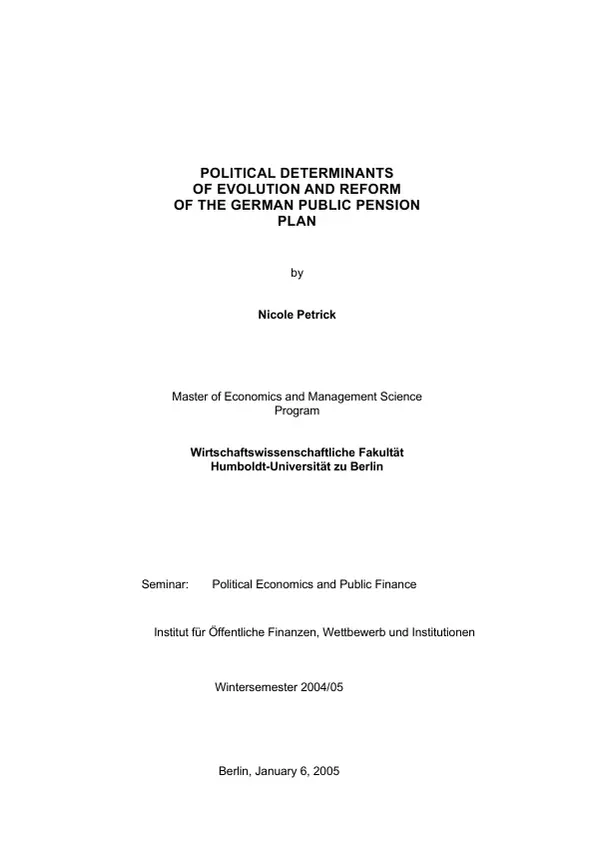The paper discusses the evolution and reform of the German public pension plan in respect to its history, theoretical approaches to explain the choice and evolution of pension plans and takes current issues in account in order to evaluate the suggestions made and to show what political determinants influence future reform.
Part 1 of this paper will give a short review of the history of the German public pension plan between the late 19th century and today. Part 2 will show how decisions made in the past could be explained and will use political approaches to explain the choice and evolution of pension schemes and pension reform. Part 3 of this paper will then consider the current problems faced by the pension system and will discuss different proposals made. It will consider the current situation of the German public pension plan and will use political determinants in order to examine how the future reform of the public pension fund in Germany could develop. A small critique will be given at the end.
Inhaltsverzeichnis (Table of Contents)
- History of the German public pension plan
- The median and indifference age for Germany
- Age pyramid of the German Empire in 1875 and of Germany in 2001
- Development of population and age quotient in Germany 2000-2050
- Monthly development of total and long-time unemployment 2003-2004
- Development of statutory pension insurance scheme (GRV)
- Estimated future contribution rates
- Polit-economic theory of public pension schemes and pension reform
- Voting on the financing method and the benefit level
- A model of a representative democracy
- Political feasibility of pension reform
- Future reform of the public pension system – a polit-economic view
- Problems faced today
- Demographic developments
- Current issues of unemployment
- Implications for the development of the contribution rate
- Suggestions made
- Political Determinants
- Critique
Zielsetzung und Themenschwerpunkte (Objectives and Key Themes)
This paper examines the evolution and reform of the German public pension plan, drawing on historical context, theoretical approaches, and contemporary issues to assess reform proposals and analyze political determinants. It seeks to understand how political considerations shape the design and evolution of pension systems.
- The historical development of the German public pension plan
- Polit-economic theories explaining the choice and evolution of pension schemes
- The impact of demographic change and unemployment on the pension system
- Current proposals for reforming the German public pension system
- The role of political factors in shaping pension reform
Zusammenfassung der Kapitel (Chapter Summaries)
The first part of the paper provides a historical overview of the German public pension plan, tracing its development from the late 19th century to the present day. It examines key demographic trends and their impact on the pension system.
The second part delves into the political economy of public pension schemes, analyzing how political factors influence the choices made regarding financing methods and benefit levels. It employs a model of representative democracy to understand the dynamics of pension reform.
The third part focuses on the current challenges facing the German pension system, including demographic changes and rising unemployment. It explores various proposals for reform and analyzes the political factors that will influence the future direction of the system.
Schlüsselwörter (Keywords)
This paper focuses on the German public pension plan, analyzing its evolution, reform, and the underlying political determinants. Key terms include: public pension system, pension reform, political economy, demographic change, unemployment, financing methods, benefit levels, political feasibility, and future reform prospects.
- Quote paper
- Nicole Petrick (Author), 2005, Political Determinants of Evolution and Reform of the German Public Pension Plan, Munich, GRIN Verlag, https://www.grin.com/document/73650



